Introduction
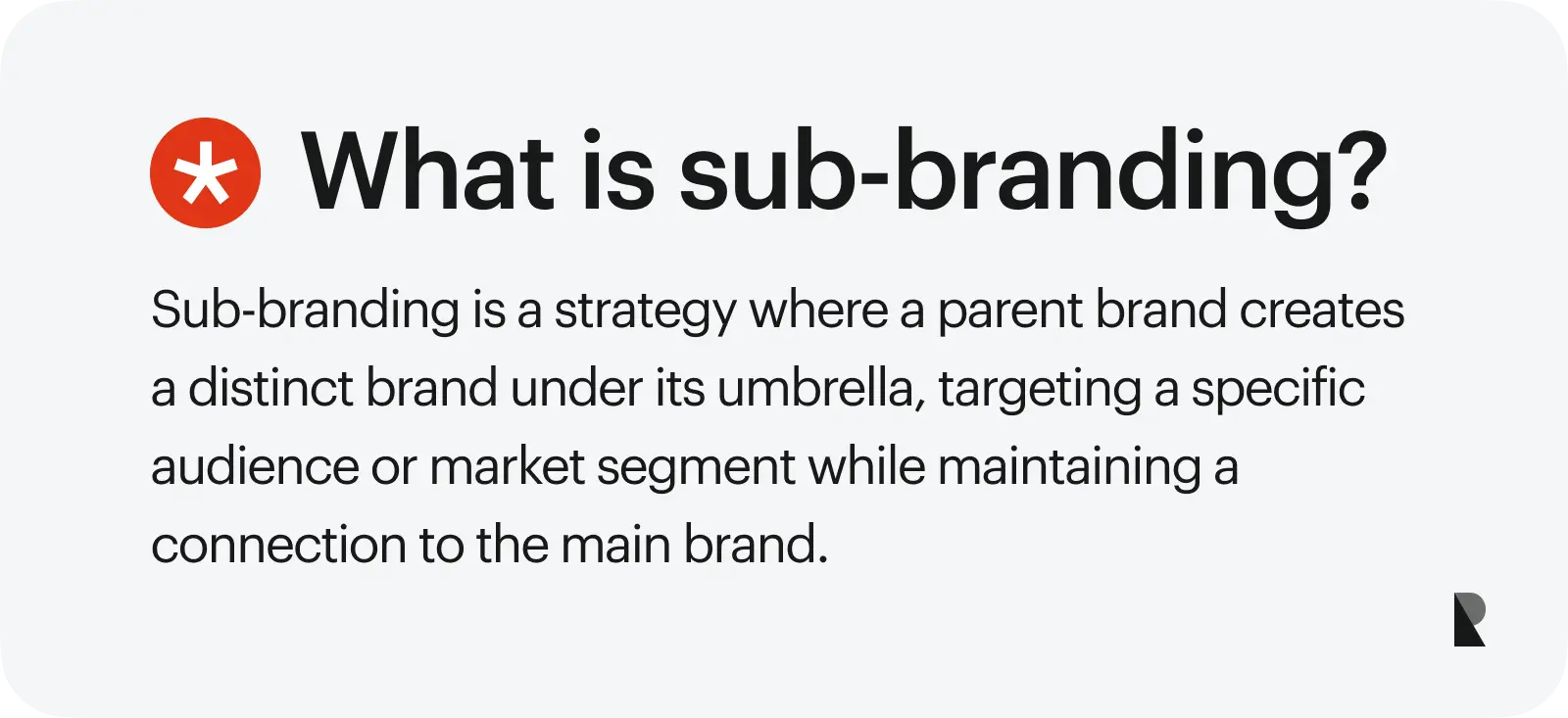
Diversifying a business's product offerings can be an effective growth strategy. It allows companies to cater to the varying needs of different customer segments. However, maintaining a comprehensive product line under a single brand can take time and effort.
An alternative approach is to create sub-brands or secondary brands. This strategic method enables the business to diversify its product portfolio without establishing entirely new major brands from the ground up.
This type of brand architecture allows businesses to diversify their products and services, target different market segments, expand brand presence, and increase profit streams, among other things.
In this scenario, the parent company often has an established, trusted, and well-known identity. Think of parent companies like Unilever, Procter & Gamble, Microsoft, and Nestle. Sub-brands are also vital in strengthening the parent brand.
But how does a sub-brand differ from a leading brand and a brand extension?
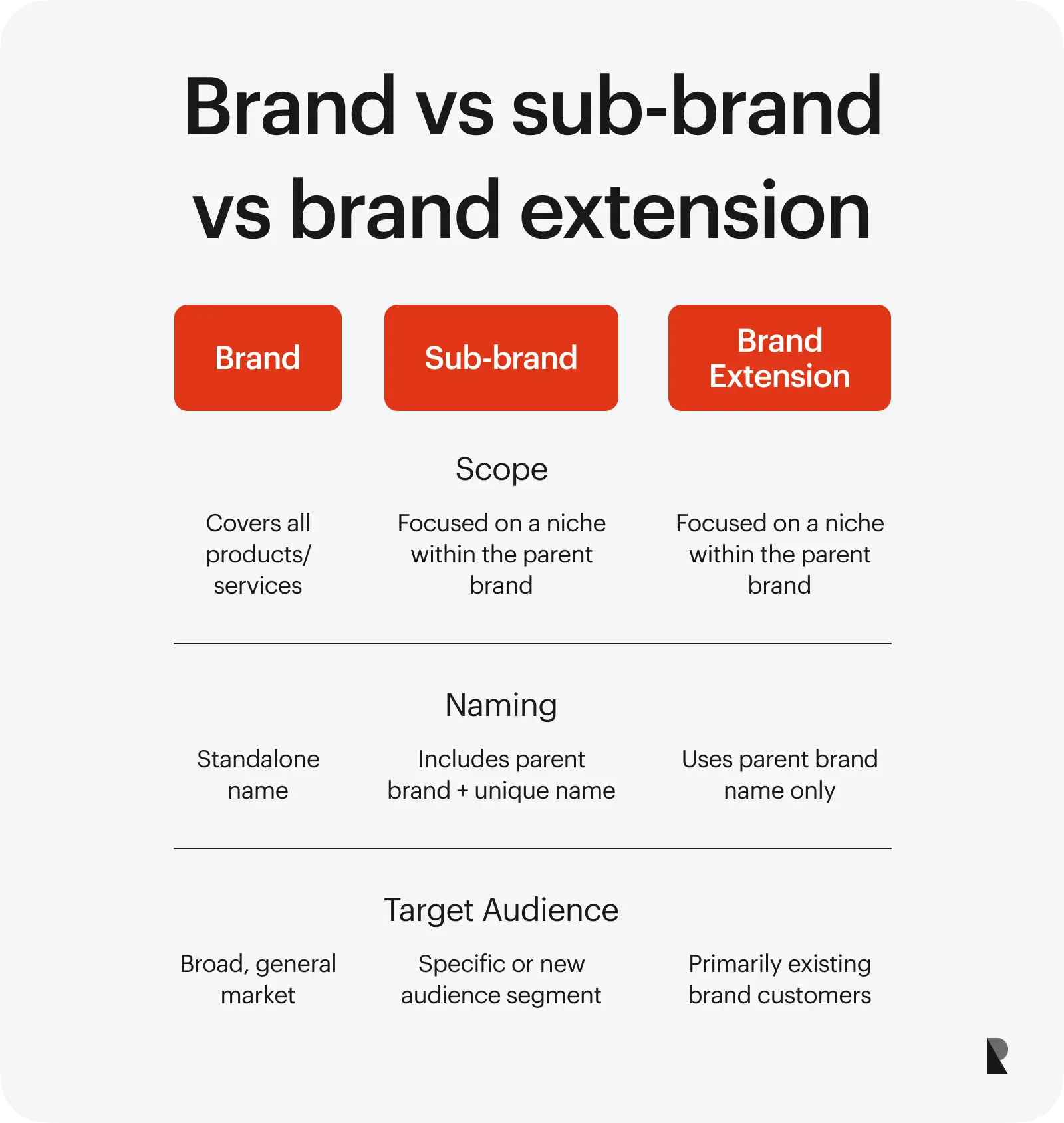
Brand vs. sub-brand
A brand is the parent brand above all minor brands. It covers everything the company makes, while a sub-brand is a smaller umbrella offering unique products and services. Typically, a sub-brand contains the name of the parent brand plus what it specializes in, like Nike Air. A sub-brand also targets a specific audience under a particular product or service category.
Sub-brands vs. brand extensions
While a sub-brand is a minor brand under the parent brand, a brand extension pertains to brands that use the parent brand name when introducing new products. A good example is the Apple Watch, where the brand name "Apple" is used for a new product category.
The key difference is that a sub-brand has a unique name that targets new and different customers, while a brand extension often attracts existing customers. When leadership teams need to make that call with confidence, they often collaborate with top branding companies to pressure-test portfolio logic, naming strategy, and audience boundaries before rollout. Apple Watch's case focuses on users who already use other existing Apple brands and are looking for tools to improve connectivity between gadgets.
Benefits of sub-branding: why companies create sub-brands
Creating sub-brands can be a strategic move for companies to achieve their goals by diversifying their offerings, reaching new markets, strengthening brand identity, and fortifying brand trust. Here's how.
1. Reach new customers
Sub-branding allows businesses to create products that appeal to people with varying interests and demands. And with the established reputation of the leading brand, you can use it to foster brand trust for your sub-brands.
For companies seeking deeper guidance on structuring these relationships and positioning sub-brands effectively, partnering with a brand strategy consulting agency can help ensure alignment between audience insights, messaging, and long-term brand equity.
2. Launch new products
Launching new products from scratch can be challenging. By implementing sub-branding, people familiar with the leading brand will likely try your latest offerings.
3. Improve competitive advantage
The market landscape can be tricky when customers' demands, preferences, and interests change. By implementing sub-branding, companies become flexible in targeting different customer bases, enabling them to remain competitive.
4. Expand to other global markets
Sub-brands can be customized to fit the local tastes of different markets. This is especially helpful in communities with language and cultural barriers.
For example, McDonald's introduced the McAloo Tikki burger in 1998, which brought something familiar yet new to the Indian market. Instead of a beef patty, the special burger contains potato and peas with Indian spices. The result? The sub-brand was a success in making Indians embrace McDonald's.
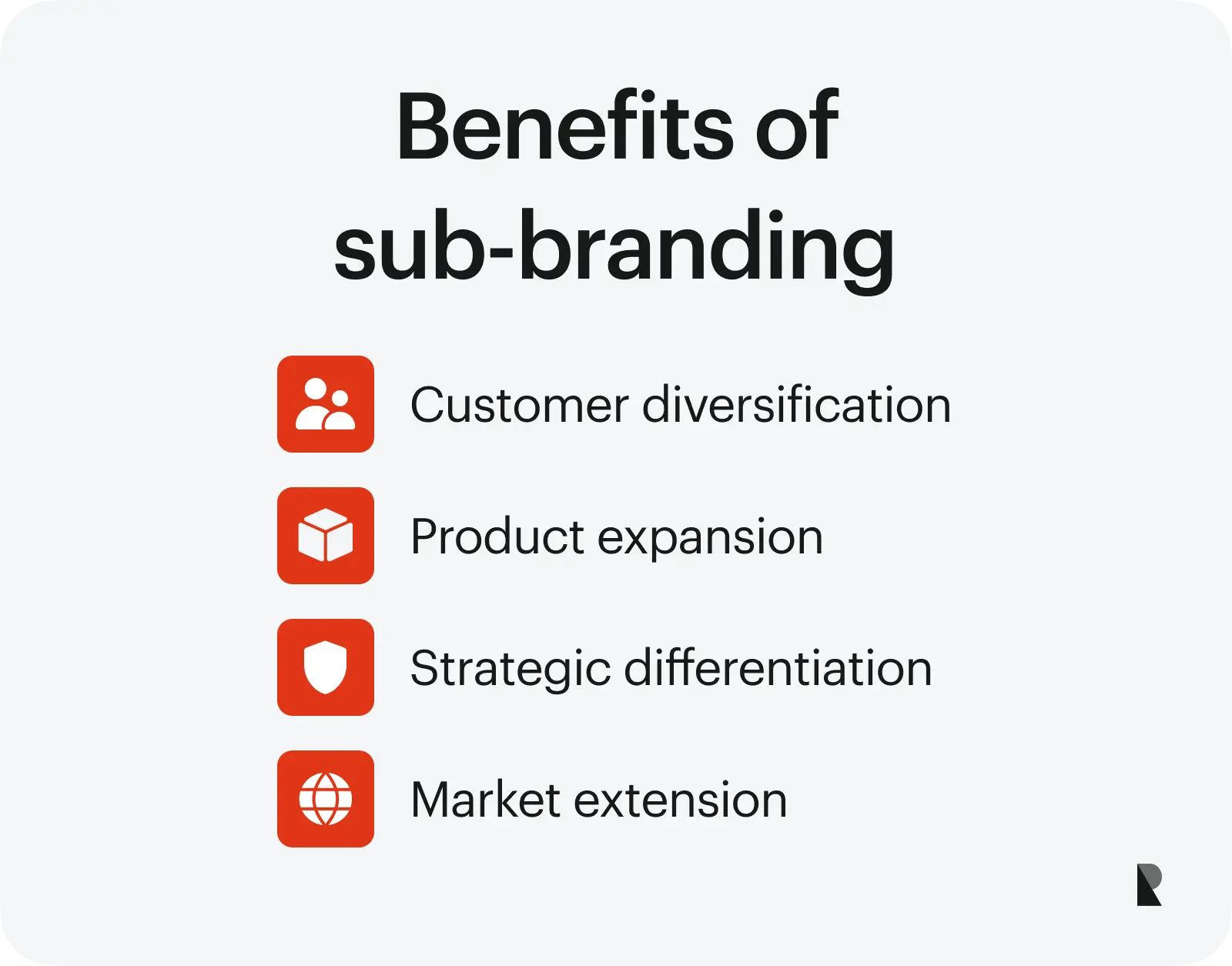
Sub-branding is like having different flavors of ice cream in one shop, attracting different customer bases so the business can grow and succeed in many places.
Challenges of sub-branding

Creating sub-brands can be an exciting venture, opening up endless possibilities. But it also comes with challenges you should plan for.
1. Costly to create and implement
Making a sub-brand can be as costly as establishing your leading brand. It requires a new marketing approach, a different team, ads, and additional product development costs. Suppose a company wants to create a new camera; funding is needed for everything from production and manufacturing to marketing and branding.
2. Lack of consistency confuses customers
Having too many sub-brands can be confusing for customers.
For starters, you need to establish several brand identities for each sub-brand. You must create different looks, messaging, and approaches while connecting them to the parent brand.
This can result in inconsistencies, especially when maintaining product quality. When a sub-brand creates doubt among consumers because of poor product quality, it can affect other brands under the parent umbrella.
3. Internal conflicts
Multiple sub-brands require different teams for each. Disagreements and other conflicts may arise between teams when different ideas and approaches are discussed. This is especially true for companies that want consistency with the leading brand.
4. High risk of failure
Not all sub-brands will succeed. Sometimes, despite spending tons of money on a new sub-brand, the failure of one sub-brand can affect others. Hence, assessing risks and having effective strategies to deal with challenges that may arise head-on before venturing into sub-branding is vital.
4 factors to consider before creating sub-brands
Sub-branding can be tedious, but when done right, it could lead to a more prosperous and strong parent brand. Below are factors you may want to consider when creating branding strategy.
Brand awareness
A parent brand with high awareness will quickly establish sub-brands as they enter the market. It already has visibility, customer loyalty, and market share.
Such status can lead to a broader audience willing to try new offerings or sub-brands. Sub-brands can also create brand identities that differentiate the unique value propositions they can bring to customers.
Target audience
The target audience is the specific group your brand wants to cater to. When a company creates a sub-brand, it can look into its target audience and segment them into different groups defined by their interests, expectations, and needs. For instance, if you are a toy company, you can create a sub-brand for kids who prefer superhero toys.
Risk assessment
The risk of a sub-brand can impact the image, value, and brand equity of the parent brand. By conducting a risk assessment, you can identify threats and weaknesses your new sub-brand may encounter. Spotting these risks early on can help companies make more intelligent decisions that will lead to success.
Brand architecture
Brand architecture refers to the structure a company implements among its brands. It shows how they relate to each other, so there is clarity. It also helps companies identify how their brands can support each other to foster growth.
An established brand architecture enables flexibility for new products without confusing customers. For example, Tide and Gillette are two different sub-brands under the parent brand, Procter & Gamble. However, because of its clear brand structure, the parent brand was able to launch and grow these sub-brands successfully.
Examples of successful sub-brands
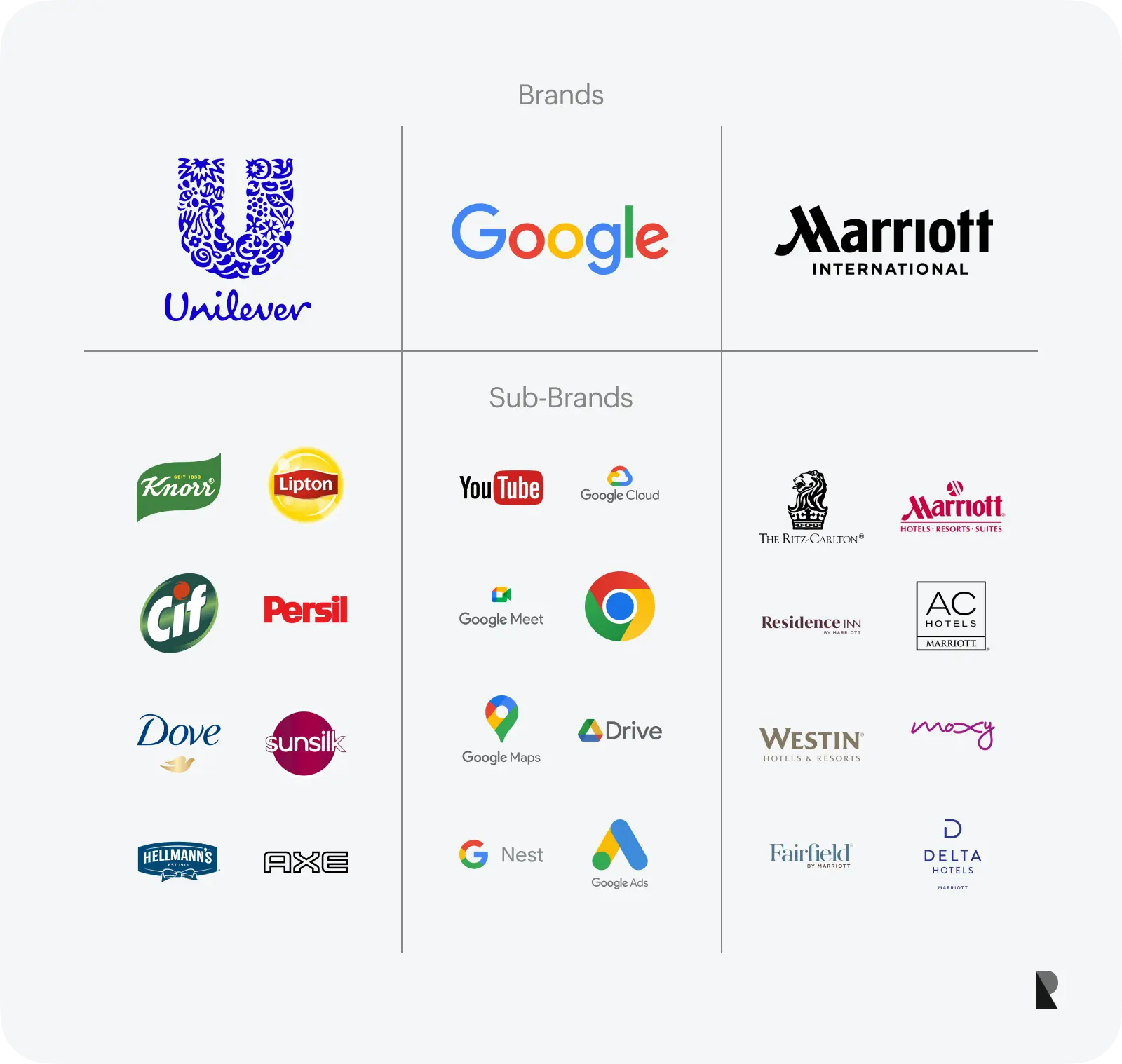
Of course, creating sub-brands is easier said than done. So, we have collected real-life brand examples from the biggest brands to inspire you in your next branding journey.
1. Unilever
Because people already trust Unilever—with almost a century of existence in the market—it is easy for them to support its sub-brands like Knorr, Comfort, and Dove. It also helps that each sub-brand focuses on specific customer needs and messaging.
Knorr is a go-to ingredient for families too busy to cook tasty meals from scratch. Dove promotes real beauty and healthy self-esteem. And Comfort focuses on fabric softeners that make clothes feel softer and smell better.
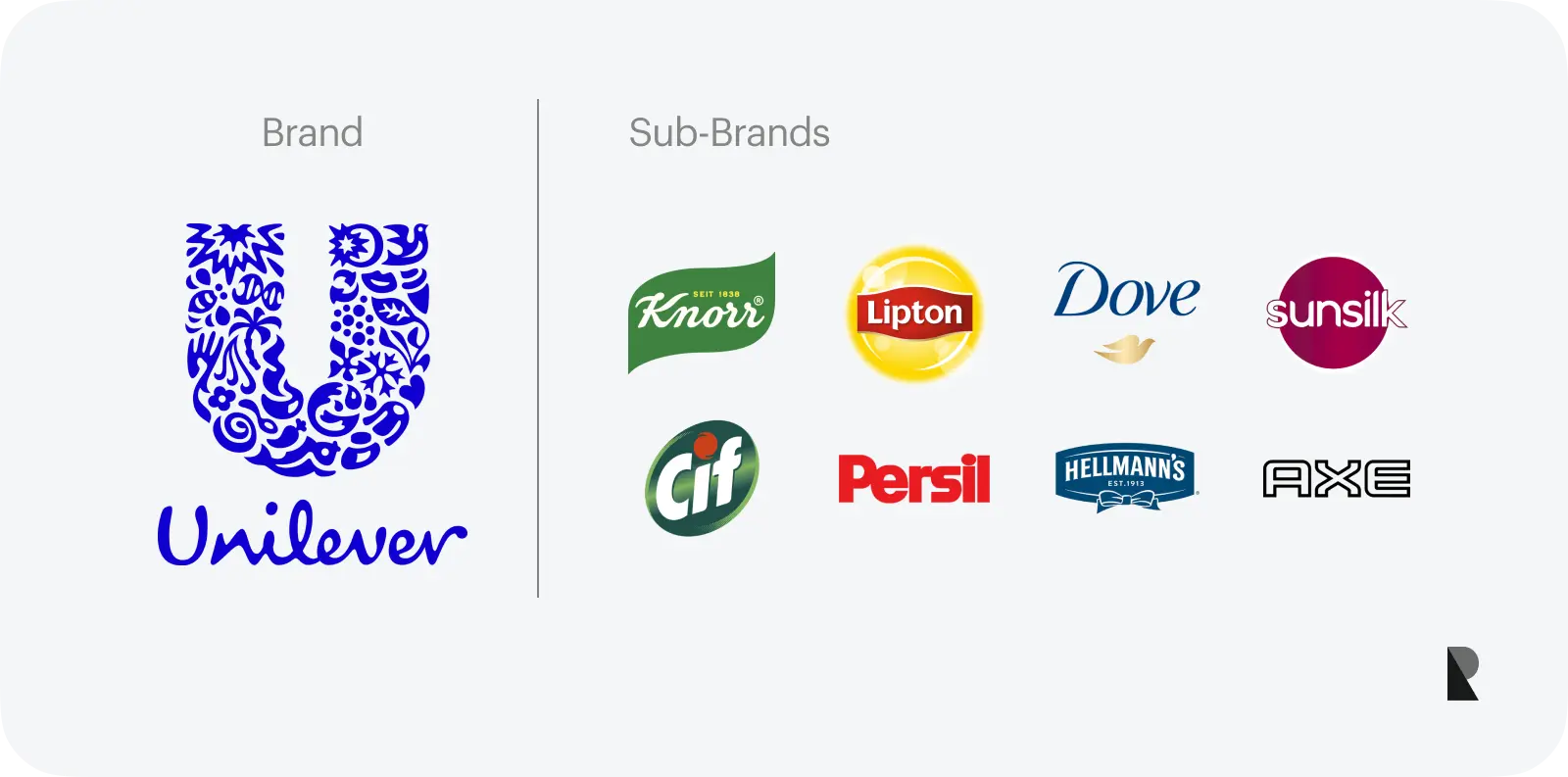
These clear distinctions in Unilever's House of Brands structure help them connect with their audiences. Most importantly, Unilever has become the gold standard in the industry for providing high-quality products at an affordable price. The company is also consistently invested in innovation, as evidenced by its diverse brand portfolio.
2. Google
Google leveraged user-centric design in creating sub-brands like Google Maps and Google Workspace (combining Gmail, Google Drive, and Google Docs, among others) that focus on different consumers looking for a unique user experience. They regularly update products according to user feedback to develop intuitive features that simplify users' lives.

The use of similar logo, color schemes, and typography across all Google products makes the brands recognizable to consumers.
Using Google in the sub-brand names immediately establishes recognition among new users for its reliability in the market. This approach encourages potential and existing users to try their tools. It also pays that Google has a seamless eco-system, allowing sub-brands to work well together to enhance user productivity.
3. Microsoft
In its early years, Microsoft was known for being the industry leader in producing operating systems and productivity software for personal and commercial use. Microsoft ventured into the gaming industry to diversify its portfolio, launching its sub-brand, Xbox.
Instead of focusing only on the gaming aspect of Xbox, Microsoft incorporated other entertainment features to create an all-in-one system for its users. This enables users to play games, stream videos, and other content, and integrate with different media and platforms like PlayStation and PC.
This inclusivity in product design has broadened its audience reach. It also used Microsoft's strong community of tech aficionados to build the network for its sub-brands and foster loyalty.
4. Marriott International
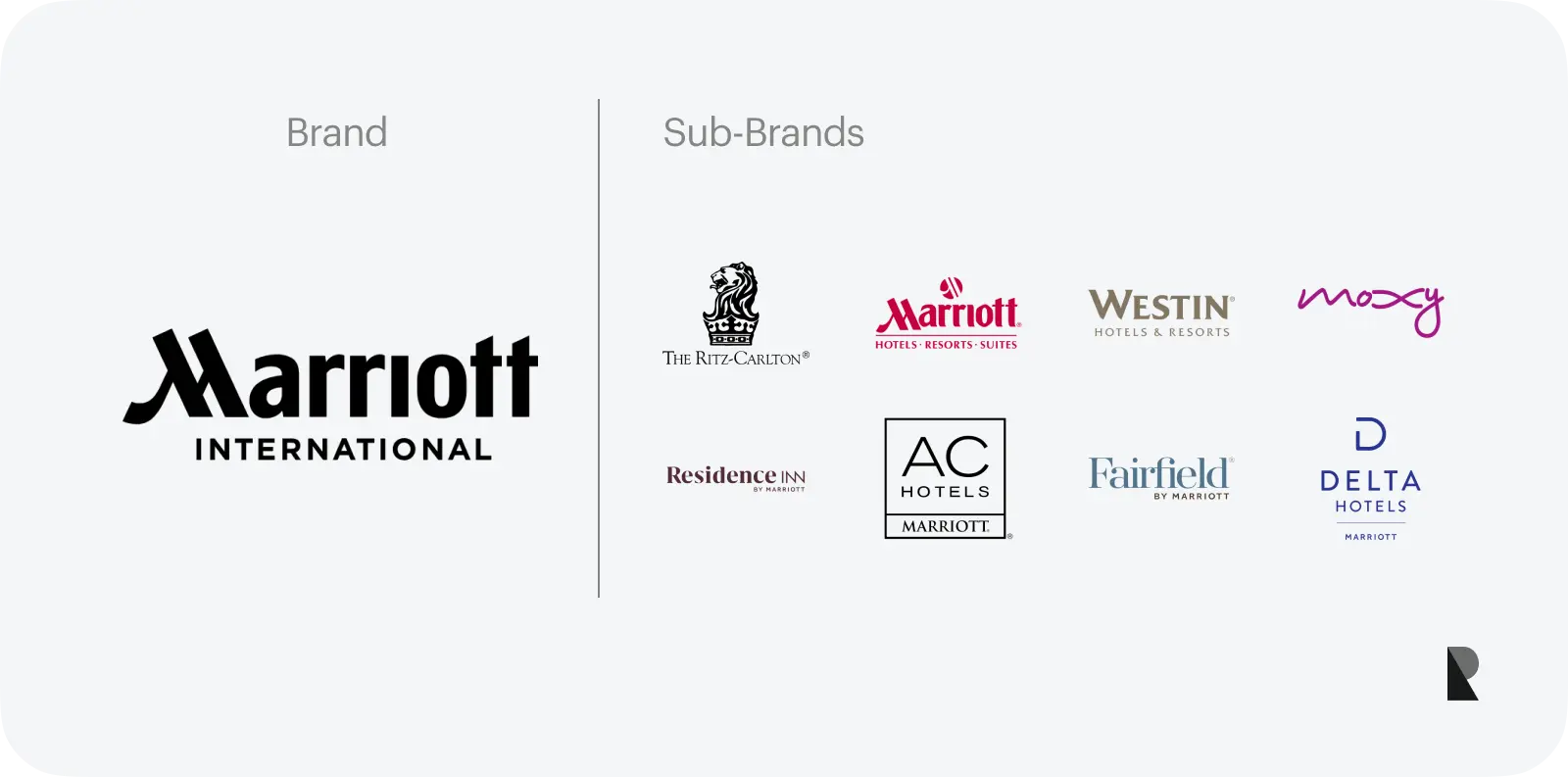
Marriott International created sub-brands with different price points to cater to customers from longer stays to luxury holidayers.
Marriott International implements a hybrid brand architecture in which its sub-brands are endorsed by the leading brand by adding "by Marriott." For instance, they have Courtyard by Marriott, which caters primarily to business travelers looking for comfortable rooms and workspaces.
Strategically acknowledging the parent brand in the sub-brand name puts potential customers at ease. Marriott is synonymous with high-quality service and is one of the industry's most trusted hotel families.
So, how do you create a sub-brand?
Step 1: Define your sub-brand’s mission and vision
Your sub-brand's mission pertains to what it can do for customers and how it does it. For instance, an eco-friendly women's clothing line can state its mission as: To create sustainable and fashionable clothes and apparel for environmentally conscious consumers by implementing ethical manufacturing practices."
Aside from making profits, your sub-brand's vision describes what your brand hopes to achieve in the long run. It clarifies the impact you want to make on the society and environment in which your brand exists.
The vision expounds on your core principles, beliefs, and values that align and resonate with your target audience. For example, your vision could be: "To be the leading sustainable brand in women's fashion, inspiring an environmentally conscious community for a better world."
Step 2: Craft a unique identity for your sub-brand: logo, color scheme, and typography
Your sub-brand's visual identity should borrow elements from the parent brand identity but still be unique to differentiate it from others. This means customizing your logo, color scheme, and typography to match the brand personality of your sub-brands and the emotions you want to evoke.
An example is Google's branded house, where all sub-brands use fonts and color schemes identical to the parent brand. Every time you release an ad or a customer sees your sub-brand packaging, the positive image of the overarching brand also comes to mind. However, the messaging, tone of voice, and personality reflect the target demographic of the sub-brand.
Finally, it is advisable to create a brand guideline that will serve as your team's rule book to avoid confusion and misuse of sub-branding elements.
Step 3: Create a marketing strategy for your sub-brand
Crafting a marketing strategy for a sub-brand starts with having the correct data and insights through thorough market research. Your goal is to understand the nuances between the audiences of your parent brand and sub-brand so you can appeal to consumers effectively. This also ensures you do not alienate the parent brand as you launch the unique identity of your sub-brand.
Assessing the support you can leverage from your parent brand is vital. For example, you can use your parent brand's social media presence to cross-promote your sub-brand, making it easier for customers to trust and try your new product. You can also collaborate with influencers that align with your sub-brand's values to connect with your niche audience.
Finally, it is crucial to monitor the progress of your campaigns so you can spot flaws and deal with them in real-time. It is also essential to remain flexible, adapting to changes based on customer feedback. By following these methods, you are well on your way to an effective marketing strategy.
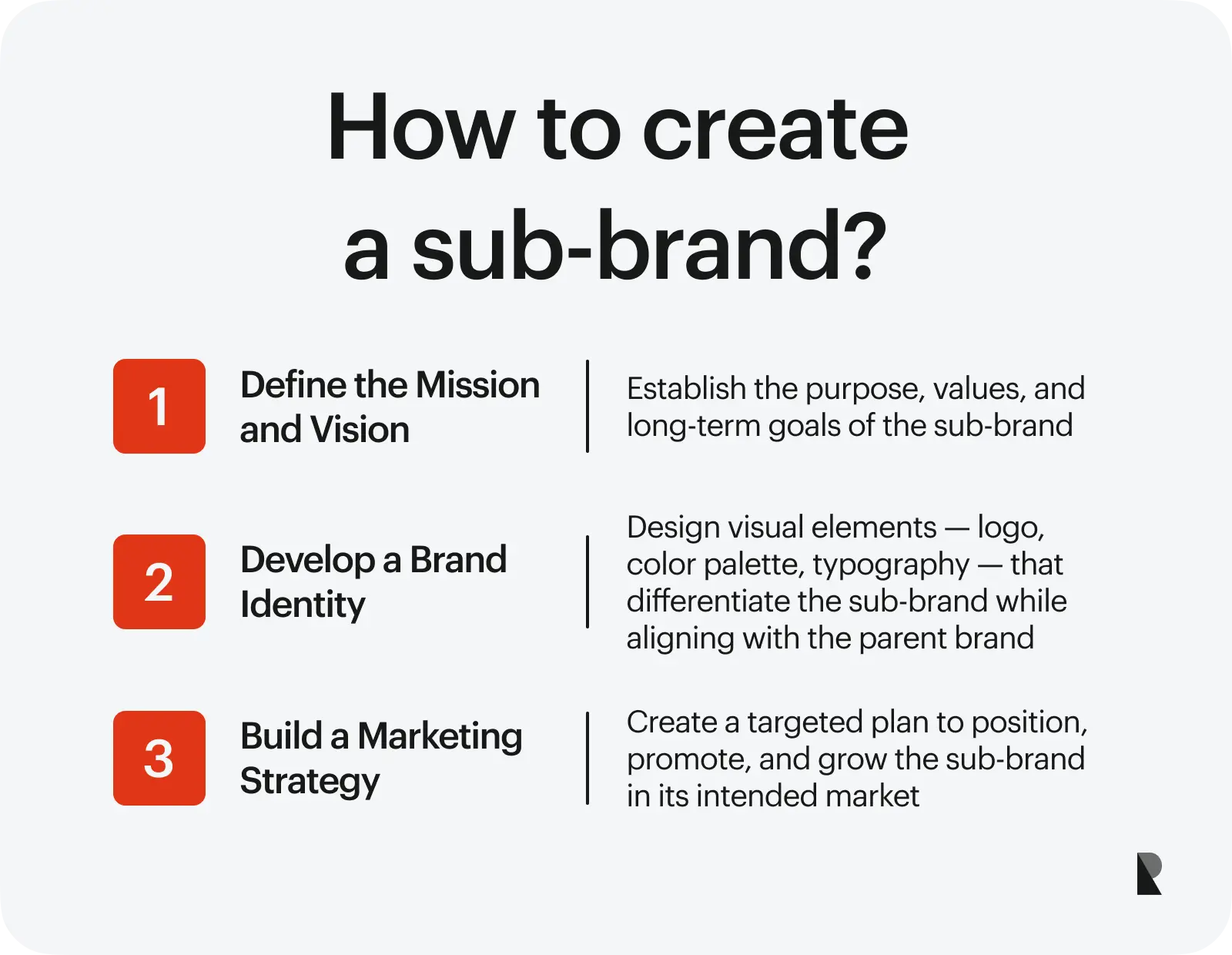
Expanding your business through sub-branding
Sub-branding requires careful planning, strategic execution, and ongoing monitoring. It is a complex process that can be challenging to navigate, but it brings tremendous benefits for businesses looking to grow.
Our brand examples demonstrate that it allows you to expand your product line, reach emerging markets effectively, and strengthen trust and loyalty within your growing community.
If you're considering sub-branding, you'll need all the help you can get if you want results. A professional brand strategy agency can help you navigate the potential pitfalls of sub-branding. They'll help you anticipate and mitigate risks, ensuring a smoother launch and stronger long-term performance.
Dec 26, 2024
